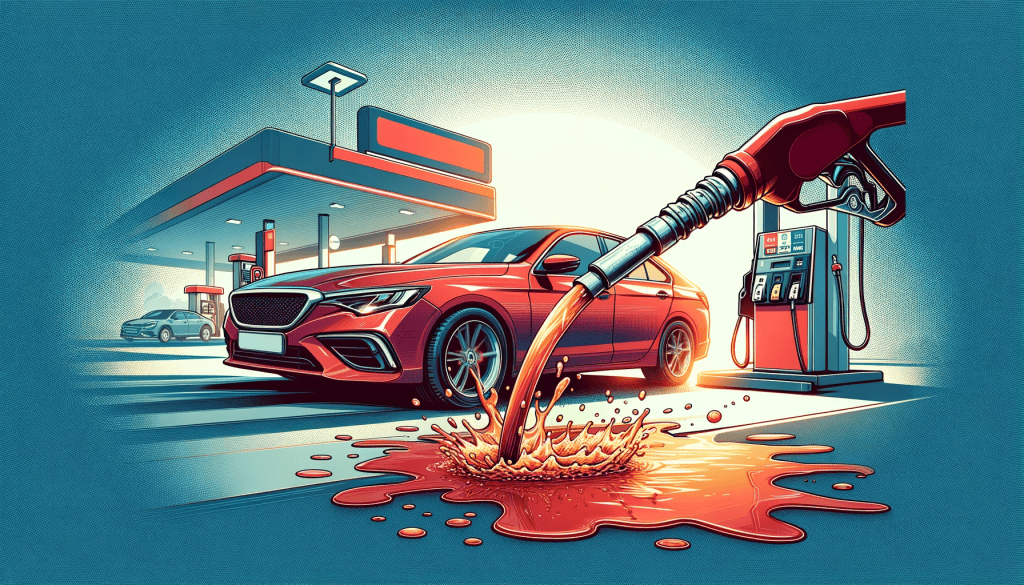When you overfill your gas tank, several issues can arise, affecting both the vehicle’s performance and safety. Here’s an in-depth look at the symptoms, consequences, remedies, and precautions regarding an overfilled gas tank.
Symptoms of An Overfilled Tank
- Fuel Odor: The most immediate sign of an overfilled gas tank is the strong smell of gasoline around the vehicle. This odor is due to fuel spillage or vapor emissions from the overfilled tank.
- Leaks: When a tank is overfilled, gasoline may leak from the tank or the fuel cap area, which can be dangerous due to the flammable nature of gasoline.
- Difficulty Starting the Engine: Excess fuel can flood the engine, making it difficult to start.
- Check Engine Light: Modern vehicles equipped with evaporative emission control systems (EVAP) can trigger the check engine light if the system detects vapor issues due to overfilling.
- Poor Fuel Economy: Overfilling can lead to fuel wastage and may negatively impact fuel economy.
Additional Symptoms and Consequences
- Emissions System Failure: Overfilling can cause the charcoal canister, a critical component of the EVAP system, to become saturated with fuel. This saturation can lead to its failure, potentially resulting in poor vehicle performance and increased emissions.
- Fuel Overflow During Hot Weather: In hot weather, the fuel in your tank can expand. If the tank is overfilled, this expansion can lead to fuel overflowing, which is a waste and an environmental hazard.
- Catalytic Converter Damage: Over time, an overfilled tank may lead to raw fuel entering the catalytic converter, which is not designed to handle liquid fuel. This can damage the converter, leading to costly repairs.
What Will An Overfilled Gas Tank Do?
Damage to the EVAP System: The most significant risk of overfilling your gas tank is damaging the EVAP system. This system captures fuel vapors before they escape into the atmosphere and recycles them back into the fuel system. Overfilling can cause liquid fuel to enter the EVAP system, leading to malfunction.
Increased Risk of Fire: Spilled fuel, either as liquid or vapor, increases the risk of fire, especially in hot weather or near ignition sources.
Environmental Harm: Spilled gasoline can harm the environment, contaminating soil and water.
Detailed Look at EVAP System and Overfilling
The EVAP system is designed to prevent gasoline vapors from escaping into the atmosphere. It includes components like the charcoal canister, purge valve, and vent valve. Overfilling the tank can force fuel into these components, disrupting their operation. This can lead to performance issues like rough idling, stalling, and difficulty starting the vehicle.
How To Fix Overfilled Gas Tank
If you realize you’ve overfilled the tank, it’s advisable not to start the car immediately to prevent fuel from entering the EVAP system. Let the excess fuel settle by parking the car in a safe, well-ventilated area and inspect the area around the fuel cap for any signs of leakage. Once you start the car, drive gently to avoid sloshing and further complications. If you notice any persistent issues or the check engine light comes on, it’s wise to have a professional inspect your vehicle.
If Overfilling Happens
Drive the Vehicle Normally: If the tank is overfilled, drive the car to burn off the excess fuel, but do so cautiously. Avoid aggressive driving until the fuel level is normalized.
Regular Inspections: If you’ve overfilled your tank, especially more than once, have your vehicle inspected for any potential damage to the EVAP system or other components.
Avoid Repeated Overfilling: Continuously overfilling your tank can lead to cumulative damage over time. Be conscious of your refueling habits to avoid repeated issues.
Can I Start the Car When the Gas Tank Overflows?
It’s not advisable to immediately start the car if the gas tank overflows. Doing so can draw excess fuel into the EVAP system, potentially causing damage. If you’ve overfilled the tank, wait for a while before starting the car, and keep an eye out for any unusual symptoms.
Conclusion
Overfilling a gas tank can lead to several problems, from minor inconveniences to significant mechanical issues. It’s always best to stop filling when the nozzle clicks off the first time. If you do overfill, taking immediate and proper steps can prevent or minimize potential damage. Regular maintenance and being mindful of your car’s needs can go a long way in ensuring its longevity and performance.


